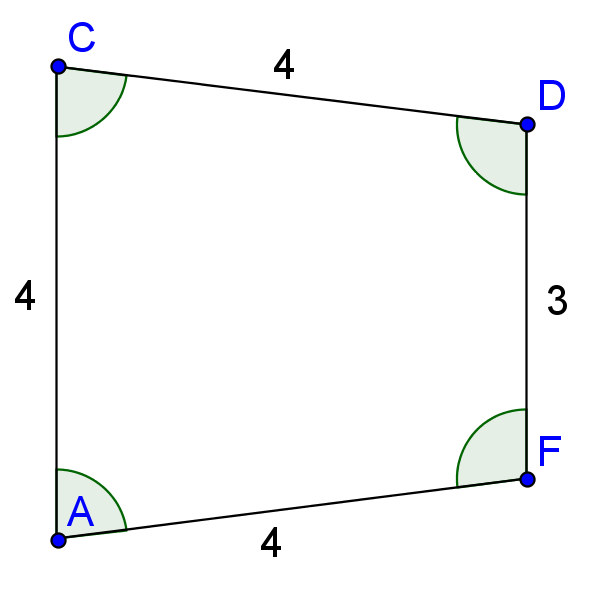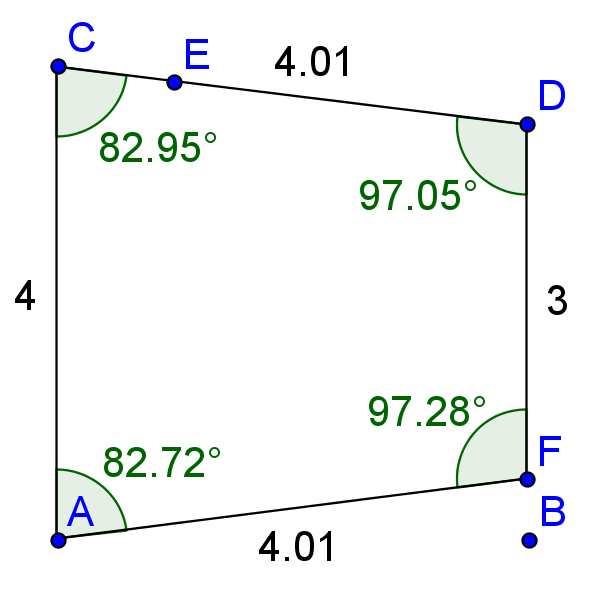My uncle called me today, and asked me a math question. Normally, I get called and asked technology related questions, but occasionally people remember that I have a mathematics background and call me in to assist.
My aunt wants to build a raised garden bed with a very particular shape. My uncle has been tasked with building it. She wants 3 of the sides of the shape to be 4 feet long, and the 4th side to be three feet long, and the whole shape should form a trapezoid (with a line of symmetry down the middle of the trapezoid). It took a little bit of chatting on the phone to get this to be clear, and I can see how being able to send each other pictures would have been really useful. To be able to build this shape as accurately as he would like, he needs to know all of the angles of the shape, so he can cut the pieces of the wood with the angles in the right position using a miter saw.

I looked at the shape and decided that the fastest solution would be to build the shape in Geogebra, and measure the angles, which resulted in this.

Not the exact solution, but close enough that my uncle would be able to use the miter saw (which has a maximum accuracy of 1 degree, according to my uncle) and cut the wood for his shape. It took me about 3 or 4 minutes to draw the shape in Geogebra and measure the angles.
After my phone call with my uncle was over, I decided that I should double check this solution though, and verify that I knew how to solve it.
I drew an imaginary line across the shape, and labelled that side x. This allowed me to create a pair of equations using the Cosine law, and I ended up with the following equation to solve:

which simplifies to:

and finally leads to this calculation:

On my calculator, that leads to a value of the smaller angle of about 82.8° and a larger angle of 97.2°, which means that my diagram that I drew for my uncle is fairly close. Wanting to be sure that my answer was correct, I also checked it using Wolfram Alpha, and on my graphing calculator.
After I told my uncle the solution, he told me that my aunt had suggested drawing the diagram carefully on a piece of paper and measuring the angles with a protractor, but he had complained that solution wasn’t "mathematical enough." Of course, this leads to a discussion of what it means to do mathematics, anyway.
Does it matter which way I solve this problem for my uncle? Which of these techniques would you classify as "mathematics"? All of them? None of them?
Rob says:
Why is drawing a line with a specific length such a difficult task using geogebra? The work-around that I have used involves circles with a specific radii, but surely there is a simpler way. I’m still rather new to that program; can anybody give me a hand here?
March 21, 2012 — 3:09 pm
David Wees says:
I think that your work around is basically the way that line segments of specific lengths are intended to be drawn; it’s how I drew the line segments above for my diagrams. This is an artifact of the origins of geometry proofs which were often done with only a compass and a straight edge, and the compass is what is used to measure distances (and hence a circle). It does seem kind of strange that a program written in the 21st century is restricted by the "rules" of geometry invented more than 2000 years ago.
April 5, 2012 — 9:37 am
Eleanor Pomerat says:
Dear Mr. Wees,
I am leaving you a comment as part of an assignment for Dr. Strange’s EDM310 class at the University of South Alabama.
Firstly, I really enjoyed reading your blog post.
You ask if it matters how you solve the problem: I think that real-life mathematics problems should be solved by using whatever tools are available, so long as you are able to carefully check over your work. It should then go without saying that regardless of the method/technique used, I would classify it as mathematics. I noticed that you used quite a few techniques to check you work. Do you think that it’s important to use more than one technique, when finding the solution to a mathematical problem?
Best,
Eleanor Pomerat
My Blog
My Twitter
March 26, 2012 — 12:59 am
David Wees says:
If you really want to make sure that your answer is correct (which I did before posting it publicly on my blog!), you should employ a variety of techniques, and also seek outside input. It’s so easy to make a conceptual error in mathematics that it is always worth checking the validity of your answer with respect to the situation it is attempting to address. This is not to say that errors are not valuable in the learning process! What I’m trying to say is that we should do our work with the expectation that we will make errors, and that we can address these errors by using a variety of different mathematics.
April 5, 2012 — 9:42 am